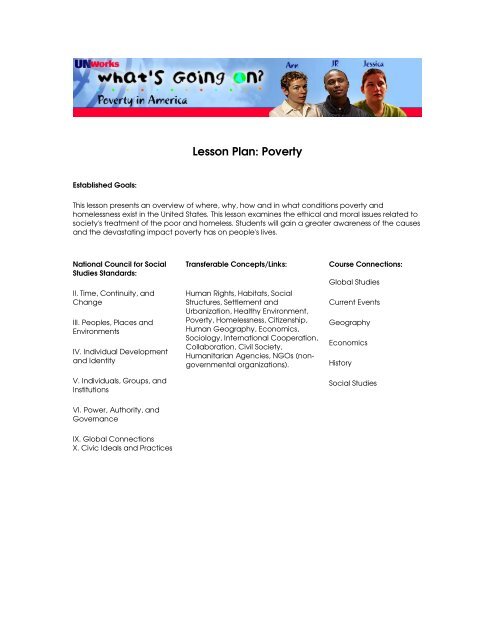lesson plan for this program - Social Studies School Service
lesson plan for this program - Social Studies School Service
lesson plan for this program - Social Studies School Service
- No tags were found...
You also want an ePaper? Increase the reach of your titles
YUMPU automatically turns print PDFs into web optimized ePapers that Google loves.
Equipment and Materials:<br />
Television and DVD or VHS player<br />
Computer with access to the internet<br />
'What's Going On? Poverty in America, hosted by Tim Robbins. Meet Jessica, who cares <strong>for</strong> her<br />
siblings while her dad works long hours <strong>for</strong> low pay, and J.R., who thinks shelter life is like being in<br />
prison.<br />
Convention on the Rights of the Child<br />
http://www.unhchr.ch/html/menu3/b/k2crc.htm<br />
Learning Activities<br />
Activity 1:<br />
1. Write the term 'home' on the board. Ask students to think about words, ideas and emotions they<br />
associate with the term. Write responses on the board, <strong>for</strong>ming a word web around the term<br />
'home.' Some answers might include: building, space, security, protection, privacy, warmth.<br />
2. Next to the word chart ask students to list activities people do at 'home.' Answers might include:<br />
sleep, eat, read, play, watch TV, do work, and bathe.<br />
Think about getting ready <strong>for</strong> school in the morning at your home: brushing your teeth, bathing,<br />
getting dressed, eating breakfast, etc. What might it be like to do all of these things in front of<br />
strangers at a homeless shelter? What is it like to get ready <strong>for</strong> school in the car that your family<br />
lives in? What is it like to try and do homework while caring <strong>for</strong> siblings or in a parents' car?<br />
In a class discussion or written response ask students: How does it feel to get ready <strong>for</strong> school in<br />
these situations? Do you think it would be hard to concentrate?<br />
3. Write "Poverty" on the board. Ask students to list words, emotions and ideas associated with <strong>this</strong><br />
term.<br />
Ask students: What are the characteristics of poverty? Can you tell if someone is poor, if so, how<br />
do you?<br />
Explain that sometimes poverty can be easily concealed. It might not be obvious that your peers<br />
and their families are struggling financially. It is important to keep an open mind and be<br />
empathetic about people's financial and housing circumstances.<br />
Note: It is important to keep in mind that there might be children in the class who might live in a<br />
homeless shelter or consider themselves poor. These children might be embarrassed by the<br />
discussion. It is important to ensure that the classroom discussion is respectful and nondiscriminatory.
2. Share these facts with your students:<br />
Every 43 seconds a child is born into poverty in the US.<br />
Every 53 minutes a child dies from causes related to poverty in the US.<br />
Today, one in ten families in America lives in poverty.<br />
<br />
Since 2000, the number of poor Americans has grown by more than 6 million to a total of 37<br />
million.<br />
The U.S. Census Bureau defines poor families as those with cash incomes of less than $15,067 a<br />
year <strong>for</strong> a family of three - or $19,307 <strong>for</strong> a family of four.<br />
The official poverty rate in 2004 (the most current year <strong>for</strong> which figures are available) was 12.7<br />
%, up from 12.5 % in 2003.<br />
On average, more than one out of every three Americans - 37 % of all people in the United<br />
States - are officially classified as living in poverty at least 2 months out of the year.<br />
Atlanta has the highest poverty rate with 48.1% poor people living below the poverty line. The<br />
number of Americans living in severe poverty - with incomes below half of the poverty line are<br />
estimated at around 15.6 million.<br />
Texas has the highest percentage (19.9%) of low income and uninsured children.<br />
The District of Columbia has the highest percentage (33.9%) of children under 18 living in<br />
poverty.<br />
The American Midwest and South saw the greatest numbers of people falling into poverty in<br />
2004.<br />
In the Midwest and Northeast, 11.6 % of all people live in poverty, compared to 12.6 % <strong>for</strong> the<br />
West, and 14.1 <strong>for</strong> the South - the highest of all.<br />
Being homeless makes it extremely difficult to attend school regularly.<br />
41 % of homeless children attend two or more schools a year.<br />
Homeless children have higher rates of learning disabilities and emotional and behavioral<br />
problems.<br />
The average homeless family is a 27 year-old single mother with two children under the age of<br />
six.<br />
In 2002, 34.9 million people lived in households experiencing food insecurity - that is, not<br />
enough food <strong>for</strong> basic nourishment - compared to 33.6 million in 2001 and 31 million in 1999.<br />
Twelve million of the adult residents in the United States have been homeless at least once in<br />
their lives.<br />
Children in America have higher poverty rates than adults, and people 65 and over have<br />
higher chronic poverty rates and lower exit rates.<br />
http://www.usccb.org/cchd/povertyusa/povfact11.shtml<br />
http://www.nccbuscc.org/cchd/brakethecycle/pov_usa/index.html http://www.fhfund.org/<br />
http://www.homes<strong>for</strong>thehomeless.com/<br />
3. The Convention says that all children under the age of 18 should be protected from harm.<br />
Ask students to identify and highlight which Articles of the Convention are violated when children<br />
live in poverty.<br />
Answers are: 3, 6, 9, 16, 19, 20, 21, 23, 24, 25, 27, 28, 31 and 33<br />
Ask students to rephrase the Articles 3, 6, 9, 16, 19, 20, 21, 23, 24, 25, 27, 28, 31 and 33 <strong>for</strong> an in class<br />
discussion.<br />
Note to teacher: Students should hold onto their copies of the Convention <strong>for</strong> further use during<br />
other "What's Going On?" <strong>lesson</strong> <strong>plan</strong>s. It is recommended that you have students use the<br />
following initials next to each article that is violated <strong>for</strong> each topic they learn about from the<br />
"What's Going On?" series. [Child Soldiers (CS), HIV/AIDS (AIDS), Refugees (RF), Child Labor (CL),
Landmines (LM), Girl's Education (GED), Indigenous People (IP), Northern Ireland (NI), Poverty in<br />
America (PA), Street Children (SC).<br />
Activity 4:<br />
1. Write a response to the <strong>lesson</strong>'s focus question: Why is poverty and homelessness a problem <strong>for</strong><br />
youth in America?<br />
2. Ask students to describe the challenges Jessica and J.R. face after reading their personal<br />
stories.<br />
http://www.un.org/works/goingon/poverty/goingon_poverty.html<br />
Ask students to respond emotionally to the experience of young people in the film.<br />
3. Students should <strong>for</strong>m their own groups that help lift people out of poverty. Divide students into<br />
groups of 3-5 and have them come up with the following:<br />
1. A group name and logo.<br />
2. The group's mandate and mission statement.<br />
3. Long and short term goals <strong>for</strong> the group<br />
4. Other organizations to collaborate with<br />
5. Come up with a PR campaign to in<strong>for</strong>m the school and public about their organization.<br />
Resources<br />
Websites<br />
National Center <strong>for</strong> Homeless Education<br />
http://www.serve.org/nche/<br />
Stand up <strong>for</strong> Kids<br />
http://www.standup<strong>for</strong>kids.org/<br />
Family Housing Fund<br />
http://www.fhfund.org/<br />
Homes <strong>for</strong> the Homeless<br />
http://www.homes<strong>for</strong>thehomeless.com/<br />
NCLB Action Brief: Education of Homeless Children and Youth<br />
http://www.publiceducation.org/portals/nclb/homeless/homeless.asp<br />
Grow up free from poverty<br />
http://www.grow-up-free-from-poverty.org/site/pages/ui_home.aspx<br />
Better Care Network<br />
http://www.crin.org/bcn/<br />
PANGAEA Street Children-Community Children<br />
http://pangaea.org/street_children/kids.htm
Human Rights Watch: Children's Rights<br />
http://www.hrw.org/children/street.htm<br />
Care USA<br />
http://www.care.org/about/index.asp<br />
United States Conference of Catholic Bishops<br />
http://www.usccb.org/cchd/povertyusa/<br />
Grameen Foundation<br />
http://www.grameenfoundation.org/where_we_work/<br />
Action Aid USA<br />
http://www.actionaidusa.org/<br />
One Big Village: Street Children<br />
http://www.worldvision.com.au/onebigvillage/print.asp?topicID=73<br />
Arms of Love<br />
http://www.armsoflove.org/what_street.htm<br />
Butterflies: Working <strong>for</strong> Underprivileged Children in Delhi<br />
Radio<br />
Fighting Poverty in America<br />
http://www.npr.org/templates/story/story.php?storyId=5317290<br />
Educating Homeless Kids<br />
http://www.npr.org/templates/story/story.php?storyId=1141038<br />
Promoting marriage to reduce poverty by Rachel Jones<br />
http://www.npr.org/templates/story/story.php?storyId=5675687<br />
Programs teach savings to erase poverty by Greg Allen<br />
http://www.npr.org/templates/story/story.php?storyId=5356754<br />
Gauging the benefits of living wage in L.A by Renée Montagne<br />
http://www.npr.org/templates/story/story.php?storyId=5331348<br />
Helping Dropouts Break the Cycle of Poverty by Neva Grant<br />
http://www.npr.org/templates/story/story.php?storyId=5300726<br />
A City Steps Up: Savannah Confronts Poverty by Steve Inskeep<br />
http://www.npr.org/templates/story/story.php?storyId=5232545<br />
Books<br />
Street Children: The Tragedy and Challenge of the World's Millions of Modern-Day Oliver Twists by Andy<br />
Butcher<br />
Children of the Streets by Harlan Ellison<br />
Children on the Streets of the Americas: Globalization, Homelessness and Education in the United States, Brazil,<br />
and Cuba by R. Mickelson<br />
No Place to Be: Voices of Homeless Children
Judith Berck<br />
Houghton Mifflin Company, 1992<br />
Asphalt Angels by Ineke Holtwijk, Wanda Boeke (Translator), Aneke Holtwijk<br />
Hardcover 192 pages (April 1, 1999) Front Street<br />
A Ceiling of Stars (American Girl Fiction (Paper) by Ann Howard Creel<br />
Reading level: Ages 9-12<br />
Paperback 96 pages (September 1999) Pleasant Company Publications<br />
Changing Places : A Kid's View of Shelter Living by Margie Chalofsky, Glen Finland<br />
(Contributor), Judy Wallace (Contributor), Ingrid Klass (Illustrator)<br />
Reading level: Ages 9_12<br />
Paperback 61 pages (August 1992) House; ISBN: 0876591616<br />
Lives Turned Upside Down: Homeless Children in Their Own Words and Photographs by Jim Hubbard<br />
Reading level: Ages 9-12<br />
<strong>School</strong> & Library Binding (October 1996) Simon & Schuster (Juv);<br />
Monkey Island by Paula Fox<br />
Reading level: Ages 9-12<br />
Paperback _ 151 pages Reissue edition (April 1993) Yearling Books<br />
America's Struggle against Poverty in the Twentieth Century (Paperback)<br />
by James T. Patterson<br />
Voices of the Poor: Volume 1: Can Anyone Hear Us? (World Bank Publication) by Deepa Narayan<br />
Poverty of Spirit by Johannes Baptist Metz<br />
Ending Global Poverty: A Guide to What Works by Stephen C. Smith<br />
Poverty: A History by Bronislaw Geremek and Agnreszka Kolakowska<br />
A Framework <strong>for</strong> Understanding Poverty by Ruby K. Payne<br />
The End of Poverty: Economic Possibilities <strong>for</strong> Our Time by Jeffrey D. Sachs<br />
The Working Poor: Invisible in America by David K. Shipler<br />
The Wealth and Poverty of Nations: Why Some Are So Rich and Some So Poor by David S.<br />
Understanding Poverty (Russell Sage Foundation Books) by Sheldon H. Danziger and Robert H. Haveman<br />
UNDP Poverty Report<br />
http://www.un.org/Pubs/whatsnew/e00088.htm<br />
World Economic and <strong>Social</strong> Survey 2006<br />
http://www.un.org/esa/policy/wess/index.html<br />
UNDP Support <strong>for</strong> poverty reduction strategies<br />
http://www.undp.org/poverty/publications/docs/<br />
Poverty_UNDP_Support_to_PRS_Sep2001.pdf<br />
September 2001 conference report : Poverty Reduction Strategies<br />
http://www.undp.org/poverty/publications/docs/Poverty_Bergen%20Report.pdf<br />
League table of child poverty in rich nations A
https://unp.un.org/details.aspx?entry=E00228&title=League+Table+of+Child+Poverty+in+Rich+Nations%2C+A<br />
Human rights and poverty reduction conceptual framework<br />
http://www.ohchr.org/english/about/publications/docs/Broch_Ang.pdf<br />
Films<br />
"Children Underground" directed by Edet Belzberg<br />
http://www.indiewire.com/people/int_Belzberg_Edet_010919.html<br />
Homeless To Harvard (2003) directed by Peter Levin<br />
America's War on Poverty- Directed by Leslie D. Farrell<br />
Small Fortunes: Micro credit and the Future of Poverty- Directed by<br />
Matt Whitaker<br />
American Cultural History - War Against Poverty DVD<br />
Poverty Row/New Rebels / Documentary Starring: Hollywood Chronicles<br />
The Poverty Puzzle: What Should Be Done to Help the Poor? Starring: National Issues Forum<br />
60 Minutes Beatrice's Goat<br />
Another World is possible Volume2-Poverty<br />
Poverty Row Theater Collection<br />
Charlie Rose with Jeffrey Sachs; Rodney Brooks,Eric Horvitz & Ron Brachman<br />
1967 Welfare, Poverty, Food Stamps & Financial Aid Documentary DVD: Black African American <strong>Social</strong> History<br />
Ashoka's <strong>Social</strong> Entrepreneurship Series presents creating a Poverty-Free World: Strategies from Muhammad<br />
Yunus of Grameen






